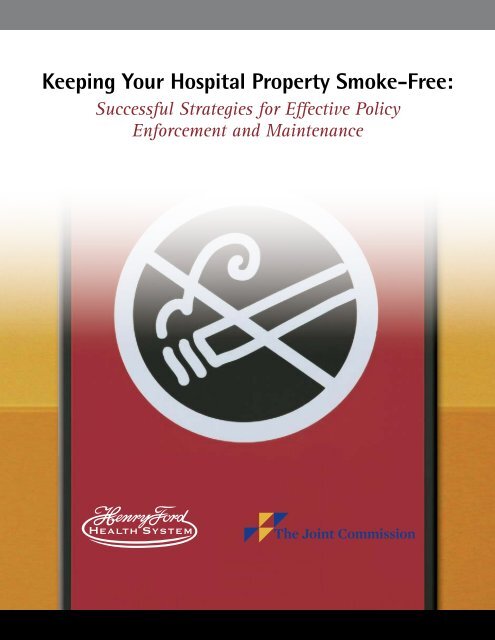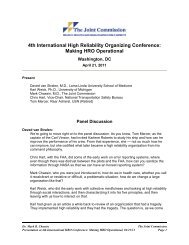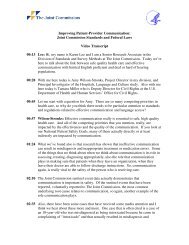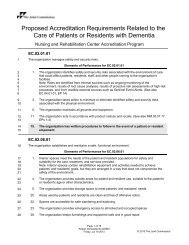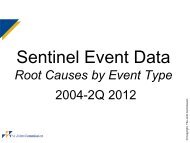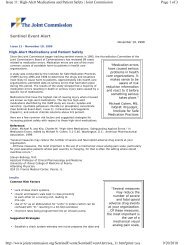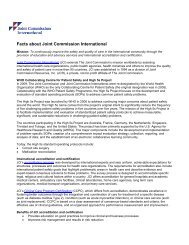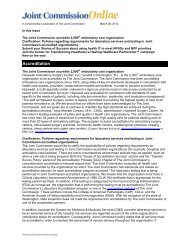Keeping Your Hospital Property Smoke-Free ... - Joint Commission
Keeping Your Hospital Property Smoke-Free ... - Joint Commission
Keeping Your Hospital Property Smoke-Free ... - Joint Commission
You also want an ePaper? Increase the reach of your titles
YUMPU automatically turns print PDFs into web optimized ePapers that Google loves.
<strong>Keeping</strong> <strong>Your</strong> <strong>Hospital</strong> <strong>Property</strong> <strong>Smoke</strong>-<strong>Free</strong>:<br />
Successful Strategies for Effective Policy<br />
Enforcement and Maintenance
KEEPING YOUR HOSPITAL PROPERTY SMOKE-FREE:<br />
Successful Strategies for Effective Policy Enforcement and Maintenance<br />
ACKNOWLEDGMENTS<br />
The authors of this publication would like to<br />
acknowledge the support of the Flight Attendant<br />
Medical Research Institute and the Robert Wood<br />
Johnson Foundation, which provided funding for<br />
different aspects of the project. We are thankful for<br />
their ongoing interest in promoting healthy,<br />
smoke-free environments.<br />
We gratefully acknowledge the assistance of hundreds<br />
of hospitals across the United States, who participated<br />
in the online survey and telephone interviews that<br />
provided the foundation for our research study and for<br />
this document. In addition, the ten organizations listed<br />
below agreed to host on-site meetings, during which<br />
they provided our research team with access to indepth<br />
knowledge and lessons learned about the process<br />
of enforcing and maintaining a smoke-free hospital<br />
property. Examples of the materials they used to support<br />
their policy implementation and enforcement processes<br />
are reprinted in this document with their express<br />
permission. Their contributions are highly esteemed<br />
and appreciated.<br />
Adventist Rehabilitation <strong>Hospital</strong> of Maryland and<br />
Shady Grove Adventist <strong>Hospital</strong>, Rockville, MD<br />
Bucyrus Community <strong>Hospital</strong>, Bucyrus, Ohio<br />
Cobb Memorial <strong>Hospital</strong>, Royston, GA<br />
Duke University <strong>Hospital</strong>, Durham, NC<br />
Eastern State <strong>Hospital</strong>, Williamsburg, VA<br />
St. Vincent’s Medical Center, Bridgeport, CT<br />
University of Michigan <strong>Hospital</strong>s and Health Centers,<br />
Ann Arbor, MI<br />
Virtua Health Inc., Marlton, NJ<br />
WakeMed Health & <strong>Hospital</strong>s, Raleigh, NC<br />
Washington Adventist <strong>Hospital</strong>, Takoma Park, MD<br />
Finally, we acknowledge the pioneering leadership<br />
in this field of the late Ronald M. Davis, MD, former<br />
director of the Henry Ford Health System Center for<br />
Health Promotion and Disease Prevention. Ron’s tireless<br />
efforts to encourage his own organization and others to<br />
adopt smoke-free policies for the health and well-being<br />
of hospital patients, visitors, and staff were crucial to<br />
ensuring that this project would come to fruition.<br />
Project staff<br />
Sharon Milberger, Sc.D., Director<br />
Amanda Holm, MPH, Project Manager<br />
Center for Health Promotion and Disease Prevention<br />
Henry Ford Health System, Detroit, MI<br />
Scott Williams, Psy.D., Associate Director<br />
Joanne M. Hafner, RN, MS, Associate Project Director<br />
Brette Tschurtz, Associate Project Director<br />
Department of Health Services Research<br />
Division of Healthcare Quality Evaluation<br />
The <strong>Joint</strong> <strong>Commission</strong>, Oakbrook Terrace, IL<br />
2
KEEPING YOUR HOSPITAL PROPERTY SMOKE-FREE:<br />
Successful Strategies for Effective Policy Enforcement and Maintenance<br />
DISCLAIMERS<br />
This document was produced as part of a research study<br />
entitled “Evaluating <strong>Smoke</strong>-<strong>Free</strong> Campus Policies in U.S.<br />
<strong>Hospital</strong>s,” and funded by the Flight Attendant Medical<br />
Research Institute (FAMRI) and the Robert Wood<br />
Johnson Foundation (RWJF). Neither FAMRI nor RWJF<br />
had any involvement in the design, implementation,<br />
analysis, results, or review of publications from the<br />
project. The goal of the study was to identify promising,<br />
practical strategies for the effective implementation of<br />
smoke-free hospital property policies. This document is<br />
the result of a three-year collaboration involving Henry<br />
Ford Health System and The <strong>Joint</strong> <strong>Commission</strong>. The<br />
findings and conclusions in this report are those of the<br />
authors and do not necessarily represent the positions<br />
of the collaborating organizations.<br />
information contained herein is derived from many<br />
sources, Henry Ford Health System and The <strong>Joint</strong><br />
<strong>Commission</strong> cannot guarantee that the information<br />
is completely accurate or error-free. We are not<br />
responsible for any claims or losses arising from the use<br />
of this document, or from any errors or omissions in it.<br />
Many of the examples included in this document<br />
come from self-reported methods, strategies, and data<br />
submitted by health care organizations to our project.<br />
Examples included are intended to aid health care<br />
organizations in their own policy implementation<br />
efforts and should not be construed as an endorsement<br />
of any specific strategy, program, or policy discussed<br />
herein. The inclusion of a health care organization<br />
name, product or service should not be construed as an<br />
endorsement of that organization, product or service,<br />
nor is failure to include any organization name, product<br />
or service to be construed as disapproval.<br />
The project staff members are solely responsible for<br />
the contents of this document. We have worked to<br />
ensure that this document contains useful information,<br />
but it is not intended to be a comprehensive source<br />
of all relevant information. In addition, because the<br />
3
KEEPING YOUR HOSPITAL PROPERTY SMOKE-FREE:<br />
Successful Strategies for Effective Policy Enforcement and Maintenance<br />
Toolkit at a Glance<br />
SECTION 1 — BEFORE YOU IMPLEMENT:<br />
Plan Ahead for Enforcement and Maintenance...........page 6<br />
SECTION 2 — ON YOUR WAY:<br />
Creating and Maintaining a Supportive<br />
Environment for Enforcement and Compliance...................page 10<br />
SECTION 3 — COMMUNICATE, COMMUNICATE,<br />
COMMUNICATE: Effective Communication<br />
Paves the Way for a Smooth Transition....................... page 13<br />
SECTION 4 — Keep Things Fresh: Monitor<br />
the Policy’s Ongoing Implementation ......................... page 17<br />
SECTION 5 — stand firm, but be flexible:<br />
Enforcement Tips and Techniques.................................. page 19<br />
SECTION 6 — PREVENTIVE MAINTENANCE:<br />
Avoiding Common Enforcement Pitfalls ......................page 21<br />
SECTION 7 — MENTAL HEALTH FACILITIES:<br />
Additional Unique Considerations................................. page 23<br />
INTRODUCTION<br />
Many hospitals recognize the value in projecting a<br />
healthy image in their community, and adopting a<br />
tobacco-free or smoke-free hospital campus policy is one<br />
way to demonstrate this commitment to health. Over the<br />
last several years, hospitals have increasingly adopted<br />
these tobacco-free or smoke-free policies as part of a<br />
nationwide trend. Correspondingly, a number of toolkits<br />
and resources have been developed and disseminated<br />
to assist healthcare organizations with establishing and<br />
implementing these policies. Once a tobacco-free or<br />
smoke-free policy has been adopted, however, there are<br />
fewer resources available to support organizations as<br />
they seek to maintain and enforce their policies.<br />
The contents of this document were developed<br />
with input from staff at hundreds of hospitals. The<br />
hospitals were selected from a pool of 1,916 healthcare<br />
organizations that completed a web-based survey about<br />
their smoking policies. 1 Subsequent to this survey, indepth<br />
telephone interviews were conducted with key<br />
administrative personnel at 182 hospitals that reported<br />
having a 100% smoke-free campus property. From<br />
this group, ten organizations were selected to host an<br />
onsite visit based on their positive experiences with the<br />
implementation and enforcement of their smoke-free<br />
property policies. Examples from their narratives and<br />
the lessons they learned are used in this document to<br />
highlight important aspects of their experiences.<br />
This document is divided into seven primary sections,<br />
each of which provides strategies to consider when<br />
enforcing your smoke-free property policy. Each section<br />
includes a list and description of successful strategies,<br />
as well as some brief examples to illustrate how the<br />
strategies were successfully implemented by hospitals.<br />
The first section, Before You Implement, is intended<br />
for organizations that have not yet implemented their<br />
smoke-free policies. This section is based upon various<br />
hospitals’ successful planning strategies, as well as<br />
some lessons learned; these are things hospitals did<br />
or wished they had done prior to implementing their<br />
policy. If you’ve already implemented your policy, you<br />
may want to jump ahead to sections two through six.<br />
Section seven applies to the unique considerations<br />
of mental health facilities. References to additional<br />
implementation resources are listed at the end of<br />
this document.<br />
1. Williams SC, Hafner JM, Morton DJ, Holm AL, Milberger SM, Koss RG, Loeb JM. The adoption of smoke-free hospital campuses in<br />
the United States. Tob Control. 2009;18:451-458 Published Online First: 20 August.<br />
4
KEEPING YOUR HOSPITAL PROPERTY SMOKE-FREE:<br />
Successful Strategies for Effective Policy Enforcement and Maintenance<br />
The strategies described in this document are intended to assist you<br />
in the ongoing implementation and enforcement of your policy –<br />
to address what happens after the “big day” has occurred and the<br />
milestone of going smoke-free is successfully reached and celebrated.<br />
These strategies are intended to be brief recommendations related<br />
to the effective enforcement of smoke-free policies, so that you can<br />
maintain your momentum after the initial implementation of<br />
your policy.<br />
Please keep two things in mind as you read this document. First,<br />
we want to emphasize an overarching theme that emerged when<br />
discussing these policies with both administrative and front-line staff<br />
at dozens of organizations: The support of leadership in all areas of<br />
policy implementation and enforcement is crucial to success. <strong>Hospital</strong><br />
staff members that we interviewed attested to the importance of this<br />
support, repeatedly emphasizing that the message that the policy<br />
is “the right thing to do” must come from the top. Leadership that<br />
is strongly supportive of the policy is a key element for successful<br />
implementation and enforcement.<br />
Second, we also frequently heard that hospitals’ worst fears about<br />
policy implementation were never realized. While you should<br />
definitely plan ahead to address concerns you foresee, don’t let<br />
those concerns prevent you from moving forward. As one hospital<br />
representative put it, “I have been in health care for about 30 years<br />
and for 28 of them I was told this couldn’t be done. But then it really<br />
couldn’t have been any easier…” So take heart – many organizations<br />
have had success with these policies. Learn from them, and your<br />
organization will too.<br />
“Everything went just how it was<br />
supposed to. We spent a lot of time<br />
examining every possible thing that<br />
could happen and how we would<br />
handle it. How would we handle a<br />
patient refusing not to smoke, how<br />
would we handle and discipline<br />
an employee who refused to<br />
comply? How would we handle<br />
a family member who refused to<br />
follow the policy? When we finally<br />
did go live, all of these concerns<br />
just kind of went away, nothing<br />
happened. We’ve spoken to a lot<br />
of organizations who have sort of<br />
echoed this same sentiment. From<br />
an administration point of view, I<br />
think we always think we are going<br />
to be the bad guy, maybe that is<br />
just natural to think that way, but<br />
then none of it occurred.”<br />
Interim CEO, medium-sized hospital in a<br />
rural setting<br />
We hope that you find the following material useful, and applaud your<br />
efforts to successfully implement your smoke-free hospital policy.<br />
5
KEEPING YOUR HOSPITAL PROPERTY SMOKE-FREE:<br />
Successful Strategies for Effective Policy Enforcement and Maintenance<br />
“Integrate wellness into every<br />
process so it’s built in and then you<br />
don’t have to keep repeating the<br />
message...”<br />
Director of Benefits and Wellness, large<br />
health system in a suburban setting<br />
A note on terminology: Different facilities<br />
use different words and phrases to refer to their<br />
organizations and policies. This can create confusion.<br />
Is there a difference, for example, between an<br />
organization’s claim of having a “smoke-free campus”<br />
versus a “tobacco-free property”? In this document we<br />
generally use the phrase smoke-free property, as our<br />
initial inquiries centered around facilities being 100%<br />
smoke-free. That is, they prohibit smoking everywhere,<br />
but they do not necessarily address other forms of<br />
tobacco use. An organization may opt to go “tobaccofree”<br />
by prohibiting all forms of tobacco use, but this is a<br />
more stringent standard that not all adopt.<br />
Regarding the choice between “property” and “campus,”<br />
we have opted for the word “property.” Several<br />
hospitals explained that the concept of “property” (as<br />
opposed to “campus”) is more easily understood by<br />
the general public. Lastly, we frequently use the term<br />
“hospital” in this document, because these organizations<br />
predominated in our interviews and site visits. However,<br />
many different types of healthcare organizations may<br />
benefit from the suggestions and strategies outlined in<br />
this document.<br />
SECTION 1<br />
BEFORE YOU<br />
IMPLEMENT:<br />
Plan Ahead for Enforcement<br />
and Maintenance<br />
Successful Strategies at a Glance:<br />
• Approach the smoke-free policy as a health and wellness initiative.<br />
• Collaborate with other organizations in the community.<br />
• Form a task force dedicated to enforcement.<br />
• Include smokers in planning the policy’s implementation.<br />
• Anticipate the impact on other corporate policies.<br />
• Define your boundaries carefully.<br />
• Allow for plenty of lead time, but don’t phase the policy in.<br />
Approach the smoke-free policy as a health and<br />
wellness initiative.<br />
If you already have a policy in place, don’t worry – there’s still more<br />
you can do after the fact to enhance enforcement. However, if you’re<br />
still in the planning stages, consider these strategies. The successful<br />
implementation of your policy often depends on your approach.<br />
Many organizations have found it helpful to promote the policy as<br />
one part of a comprehensive approach to health and wellness, in<br />
which employees are supported in making all kinds of healthy choices<br />
related to physical activity, nutrition, and other lifestyle behaviors.<br />
Incorporate the smoke-free property policy into your overall wellness<br />
planning, including the wellness incentives you expect to offer to<br />
employees. This may help avoid making smokers feel singled out,<br />
punished, or scolded. Approach the policy adoption and enforcement<br />
process as a chance to make a positive impact on the health of your<br />
employees, patients, and the community.<br />
6
KEEPING YOUR HOSPITAL PROPERTY SMOKE-FREE:<br />
Successful Strategies for Effective Policy Enforcement and Maintenance<br />
Case Examples: One small hospital in a rural<br />
setting understood that when smokers quit, they<br />
often experience a subsequent weight gain.<br />
The hospital therefore included in its employee<br />
wellness incentive program a 20-pound “credit”<br />
to those who quit smoking. That way, they<br />
reasoned, even if employees gained a little<br />
weight on their way to a tobacco-free lifestyle,<br />
they would still be recognized for their efforts<br />
and receive the benefit of the incentive. This<br />
demonstrated the hospital administration’s<br />
understanding and compassion for those who<br />
undertook this crucial lifestyle behavior change.<br />
Similarly, at a large healthcare organization in an<br />
urban setting, the smoke-free policy opened the<br />
door to other hospital-wide health initiatives. The<br />
wellness project that followed on the heels of the<br />
smoke-free property policy introduced healthier<br />
meal options in the cafeteria.<br />
Collaborate with other organizations and local<br />
government entities in your community.<br />
When the policy is similar at all health care organizations in<br />
the area, it's that much easier for everyone to comply — and<br />
no one can claim any competitive advantage. Collaborating<br />
with other healthcare organizations will likely garner you<br />
heightened media attention, and that attention will be<br />
much more positive when a united front is presented. Some<br />
organizations even agree to use similar language both in<br />
their policies and on signage.<br />
This is also an excellent time to reach out to public health<br />
and prevention-oriented organizations, to ask for their<br />
assistance and join in their efforts to reduce tobacco use.<br />
Local ordinances may be useful in encouraging compliance,<br />
especially in public areas adjacent to your property. If<br />
smoking near perimeters or on public sidewalks is an issue,<br />
work with your local government to see if an ordinance<br />
can be adopted to bolster your policy and its enforcement.<br />
Enlisting community support for tobacco prevention and<br />
control through a variety of venues will help promote<br />
a consistent message. Be an active player in your local<br />
tobacco control coalition, and community members will<br />
see that you are addressing the issue from several angles.<br />
Form a task force dedicated to enforcement which<br />
includes smokers in the planning and implementation.<br />
Most organizations form at least one task force to direct<br />
the overall policy development and implementation, along<br />
with subcommittees to address specific issues. Consider<br />
forming a team specifically dedicated to enforcement.<br />
If possible, maintain your enforcement task force as a<br />
standing committee after the policy is in place, so that<br />
progress in policy implementation and enforcement can<br />
be monitored and procedures can be modified as needed.<br />
It is important to have smokers and former smokers<br />
well-represented on these committees. This helps to<br />
ensure the policy and the support services you offer<br />
will meet smokers’ needs, and eases concerns that the<br />
policy will be punitive. The smokers on the committee<br />
will know where problem areas are likely to be and what<br />
kind of resistance may be encountered.<br />
In fact, during planning, consider forming an “allsmokers”<br />
committee to test out different aspects of<br />
the policy, including the resources and programs you<br />
plan to offer to employees, patients and visitors who<br />
smoke. These committee members may later become the<br />
champions of the policy among smokers, and often go<br />
on to become ex-smokers.<br />
7
KEEPING YOUR HOSPITAL PROPERTY SMOKE-FREE:<br />
Successful Strategies for Effective Policy Enforcement and Maintenance<br />
“Give people time to adjust.<br />
You can’t just say ‘tomorrow<br />
we are going smoke-free.’ You<br />
have to have some sort of peace<br />
offering in the form of nicotine<br />
replacement therapy aids and<br />
support. Let them know that you<br />
are there to help.”<br />
Director of Healthcare Improvement,<br />
medium-sized hospital in an urban setting<br />
Anticipate the impact on other corporate policies.<br />
To ensure successful implementation, the smoke-free policy should<br />
mesh seamlessly with your existing policies and practices. Many<br />
hospitals make the smoke-free policy subject to the standard<br />
progressive discipline process. Consider how managers’ job<br />
descriptions should be written or revised to incorporate enforcement<br />
of the policy. It is also important to account for the impact of the<br />
policy on break time for employees. For example, will hourly workers<br />
be able to clock in and out for breaks in a timely way? Should<br />
smoking on breaks be allowed? If so, does that include non-meal<br />
breaks? Whatever your team decides, these questions should be<br />
explicitly addressed in a consistent fashion.<br />
Case Example: At one medium-sized medical center in a rural<br />
setting, adhering to the smoke-free policy is a condition of<br />
employment for staff, physicians, and even for those wishing to<br />
volunteer. Staff members are not allowed to leave during breaks<br />
taken on paid time, and may only leave on an unpaid break if<br />
they have permission, and if they clock out. If they violate the<br />
policy, they are subject to disciplinary action.<br />
Define your boundaries carefully.<br />
Take some time to precisely and clearly define the boundaries of<br />
your property, and consider distributing maps that illustrate where<br />
smoking is prohibited. This is especially important if your property is<br />
large or adjacent to properties that do not prohibit smoking. Public<br />
sidewalks can be especially tricky. Think carefully about how the<br />
policy will be enforced at all of your locations, including satellite<br />
clinics, health centers, or other types of facilities. This may involve<br />
reaching agreements with owners of leased property, determining<br />
whether your employees must abide by the organization’s policy or<br />
the property owner’s, or negotiating compliance with the policy by<br />
tenants who lease space in properties you own.<br />
Allow for plenty of lead time, but don’t phase the policy in.<br />
When considering how to make policy implementation easiest for<br />
8
KEEPING YOUR HOSPITAL PROPERTY SMOKE-FREE:<br />
Successful Strategies for Effective Policy Enforcement and Maintenance<br />
staff, patients, and visitors, don’t give in to the impulse<br />
to ease them into the policy too gently. For example, a<br />
phased-in approach in defining the perimeter of your<br />
smoke-free property complicates enforcement much<br />
more than it helps or softens the impact. Similarly,<br />
implementing the policy at different times for different<br />
locations can cause confusion too. It’s easier and less<br />
confusing for your staff, patients and visitors to adjust<br />
to one big organization-wide change than to a series<br />
of small changes over time, and it also makes your job<br />
easier in terms of communicating consistently.<br />
we spoke to, the anticipation of resistance to the<br />
policy was much worse than the actual pushback<br />
they encountered.<br />
Case Example: In discussing the organization’s<br />
decision to implement a “tobacco-free workday<br />
all day,” instead of just a smoke-free property<br />
policy, a representative of a large hospital in a<br />
suburban setting noted: “I strongly recommend<br />
not just going smoke-free – we didn’t want<br />
any employee near an entrance of the hospital<br />
smoking or coming back smelling like smoke.<br />
I encourage you to bite the bullet – we’ve<br />
had no headaches from it and it’s just one<br />
implementation [instead of many].”<br />
While some organizations opt for “soft enforcement”<br />
during the first few months of implementation to lessen<br />
the perception that the policy is unduly harsh, others<br />
approach the policy’s implementation as they do any<br />
other hospital policy. Many employ the “three strikes<br />
and you’re out” model when an employee is reported<br />
to have violated the smoking policy; however, few<br />
organizations report ever reaching this point with<br />
any employee.<br />
Generally speaking, as long as you’ve provided plenty of<br />
lead time to prepare everyone for the change, people will<br />
adjust quickly. Remember, in nearly every organization<br />
9
KEEPING YOUR HOSPITAL PROPERTY SMOKE-FREE:<br />
Successful Strategies for Effective Policy Enforcement and Maintenance<br />
SECTION 2<br />
ON YOUR WAY:<br />
Creating and Maintaining a Supportive<br />
Environment for Enforcement and Compliance<br />
Successful Strategies at a Glance:<br />
• Take a compassionate approach when interacting with smokers.<br />
• Document and track employee tobacco use and cessation prior to<br />
and after policy implementation.<br />
• Be consistent.<br />
• All employees should participate in enforcing the policy.<br />
Take a compassionate approach when interacting with smokers.<br />
While the great majority of smokers want to quit, the smoke-free policy<br />
may still seem like a hardship to some. Taking a compassionate and<br />
non-judgmental approach will help alleviate the stress of complying<br />
with the new rules. Keep in mind the addictive nature of nicotine<br />
and the difficulty involved in quitting as you craft your enforcement<br />
strategies. Offer resources for short-term cessation and relief of<br />
withdrawal symptoms to staff, patients and, if possible, visitors. It’s<br />
also important to support the long-term cessation efforts of employees<br />
who use tobacco. Living with a smoker can be a major obstacle to<br />
quitting, so if you can afford to, offer programs and resources to<br />
employees’ loved ones as well. Any resources you can provide to<br />
help employees quit using tobacco products will foster acceptance of<br />
and compliance with the policy. Incentives such as wellness credits<br />
towards reducing health insurance deductibles, or reduced cost (or free)<br />
cessation programs or nicotine replacement therapy (NRT), for instance,<br />
are well-received and can aid in compliance.<br />
Document and track employee tobacco use and cessation<br />
prior to and after policy implementation.<br />
As stakeholders see tangible benefits resulting from the policy, they<br />
are more likely to continue supporting its enforcement and any<br />
future enhancements to it. Some facilities even screen new employees<br />
for tobacco use and refer them directly to cessation services.<br />
10
KEEPING YOUR HOSPITAL PROPERTY SMOKE-FREE:<br />
Successful Strategies for Effective Policy Enforcement and Maintenance<br />
Case Example: Some hospitals created innovative, novel<br />
strategies to support smokers compassionately through the<br />
policy implementation process. One large health system in a<br />
suburban setting offered tobacco cessation medication to its<br />
employees at no cost, established “quit centers,” offered 15<br />
“How to Make it Through the Day” seminars to assist those<br />
who were not planning to quit using tobacco, and had a<br />
24-hour hotline for support. They also provided cash-back<br />
incentives and employed a hypnotist. Care packages were<br />
prepared with puzzles, a stress ball, and a coupon for a free<br />
soft drink to distribute to smokers. These gifts and resources<br />
helped support their employees through the workday and<br />
allayed concerns that the policy was adopted to punish smokers.<br />
Be consistent.<br />
If employees already feel targeted by the smoke-free policy, imagine<br />
how much worse they will feel if it is applied unevenly. Do your best<br />
to ensure consistent enforcement of the policy, including provisions<br />
affecting whether employees can smoke during break times, across<br />
all departments, locales, and shifts. Perceptions of unequal or unfair<br />
treatment could undermine effective enforcement.<br />
“For us it was making everybody<br />
responsible for the policy. It<br />
was not just the directors or the<br />
administrators, it was everybody,<br />
and they were given credit if<br />
they approached someone in a<br />
non-confrontational manner and<br />
informed them of the policy. We<br />
had education around that and we<br />
have these ‘excellent job’ cards<br />
that are given as incentives. If<br />
we saw an employee approach<br />
someone or heard about it, we’d<br />
give them a card. And actually if<br />
they didn’t it could count against<br />
them. If we knew that they saw<br />
someone smoking and didn’t do<br />
anything about it, that would be a<br />
strike against them.”<br />
Director of Quality Management, small<br />
hospital in a suburban setting<br />
11
KEEPING YOUR HOSPITAL PROPERTY SMOKE-FREE:<br />
Successful Strategies for Effective Policy Enforcement and Maintenance<br />
All employees should participate in enforcing the policy.<br />
Most organizations find that placing the burden of enforcement<br />
solely on security staff is impractical. Instead they ask and expect all<br />
employees to take part in enforcing the policy. However, not everyone<br />
will be comfortable approaching people who are violating the policy.<br />
To alleviate their anxieties, offer training and “how-to” resources –<br />
including scripted messages that employees can simply read off cards –<br />
to help your staff speak to individuals in a non-confrontational manner.<br />
Provide several variations on scripted messages that employees can<br />
use to start conversations about the policy, and provide print materials<br />
(cards or brochures) with policy information and cessation resources<br />
that can be handed out without engaging smokers in debate.<br />
Case Example: One large hospital in a suburban setting found<br />
that visitors smoking on the property reacted much more<br />
favorably if they were approached by employees who were not<br />
security officers. Their patients were intimidated by a person<br />
in a police-style uniform telling them they were breaking rules.<br />
Having other staff reach out to visitors put a friendlier face on<br />
the policy’s enforcement.<br />
12
KEEPING YOUR HOSPITAL PROPERTY SMOKE-FREE:<br />
Successful Strategies for Effective Policy Enforcement and Maintenance<br />
SECTION 3<br />
COMMUNICATE, COMMUNICATE,<br />
COMMUNICATE:<br />
Effective Communication Paves the Way<br />
for a Smooth Transition<br />
Successful Strategies at a Glance:<br />
• Communicate early and often.<br />
• Inform patients of the policy as soon as possible.<br />
• Word your signs carefully and update signage as needed.<br />
• Solicit input from neighbors and the local community.<br />
• Inform your vendors and contractors.<br />
Communicate early and often.<br />
From the planning phase to the implementation date and beyond,<br />
keep lines of communication open with all constituencies affected by<br />
the policy – patients, staff, visitors, neighbors, contractors, vendors,<br />
volunteers, and the general public. Use all available media, including<br />
signage, print materials, emails, paper mailings, newspaper or radio<br />
advertisements, and earned media from issuing press releases.<br />
Repeat your messages over the course of the planning and<br />
implementation periods by a variety of means. Consider holding a town<br />
hall meeting or educational session — or better yet, a series of them —<br />
during which employees can ask questions of leadership. Besides helping<br />
to disseminate correct information and dispel rumors about the policy,<br />
these events give employees opportunities to have their concerns heard,<br />
which can help to defuse complaints and morale issues.<br />
After the implementation date, provide ongoing reminders about the<br />
policy in internal publications, emails, and on your intranet and internet<br />
websites. Centralizing the flow of information can help bolster effective<br />
enforcement. Consider setting up a hotline that can serve as a “onestop”<br />
source of information about the policy, and a means by which<br />
noncompliance can be reported.<br />
13
KEEPING YOUR HOSPITAL PROPERTY SMOKE-FREE:<br />
Successful Strategies for Effective Policy Enforcement and Maintenance<br />
Share success stories of employees or others who<br />
quit tobacco as a result of the policy. This helps keep<br />
the focus on its positive health benefits. A smokefree<br />
campus fits in well with the “green community”<br />
movement, so consider including the environmental<br />
benefits of your policy in your communications about<br />
your green initiatives.<br />
As one organization told us, there is “no wrong way, just<br />
many right ways” to get the message out.<br />
Case Examples: A large health system in a<br />
suburban setting held multiple “CEO Forum”<br />
events where employees could ask questions and<br />
make their concerns heard.<br />
A representative of another large hospital in a<br />
suburban setting explained, “When [our CEO]<br />
spoke at the policy announcement meeting it<br />
was just so peaceful, so reaffirming. There were<br />
some employees who attended with the idea<br />
that they were going to start a petition, they<br />
were really against it, and she just gently and<br />
non-judgmentally informed them that this was<br />
going to happen, that it was a done deal. She<br />
explained why we were doing this, why it was so<br />
important. She made it clear that there was help<br />
for those who wanted it, but that we were not<br />
saying they couldn’t smoke, we weren’t being<br />
judgmental, they just can’t smoke here because<br />
we are promoting a message of health. As she<br />
said, we wanted to use the carrot and not<br />
the stick.”<br />
Inform patients of the policy.<br />
Patients who smoke should be informed of the policy<br />
as soon as possible, in appointment reminders, prior to<br />
planned admissions, and upon admission for acute or<br />
emergent concerns. Signs should be visible the moment<br />
anyone steps onto the property. Protocols should be<br />
in place to assist admitted patients in dealing with<br />
nicotine withdrawal during their stays. A hospital stay<br />
can also be an excellent teachable moment for quitting<br />
tobacco, so consider developing an inpatient cessation<br />
program and implementing standing orders for nicotine<br />
replacement therapy (NRT) for eligible patients.<br />
Word your signs carefully and update signage<br />
as needed.<br />
One key medium of communication will be the signs you<br />
place around your property indicating its smoke-free<br />
status. The signs and the specific wording of them are<br />
crucial to successful implementation and enforcement. So<br />
take a positive approach — be a “smoke-free property,”<br />
instead of a place where “smoking is prohibited.” The<br />
signs should be easily legible and visible, but pay<br />
attention to the connotation of the words you choose for<br />
them. For example, those that say “no smoking in this<br />
area” could be misinterpreted to mean there are smoking<br />
areas somewhere on the grounds. Instead, emphasize that<br />
the entire property is smoke-free. Based on your patient<br />
population, it might be helpful to have additional signs<br />
in languages other than English.<br />
After a period of time, you may find that employees,<br />
visitors, and patients become “sign-blind” to smoke-free<br />
property signs that they have seen many times, or that<br />
signs have become so weathered or discolored that they<br />
are hard to read. When it comes time to replace or revamp<br />
signage, consider modifying the wording of your signs<br />
to make them clearer or use this opportunity to translate<br />
14
KEEPING YOUR HOSPITAL PROPERTY SMOKE-FREE:<br />
Successful Strategies for Effective Policy Enforcement and Maintenance<br />
them into additional languages that may be common<br />
among the communities your organization serves.<br />
Solicit input from neighbors and the local<br />
community.<br />
In almost all organizations, some employees and visitors<br />
will continue to smoke, and will often travel to the<br />
border of your property to do so, which can create hard<br />
feelings among your neighbors. Inform neighboring<br />
homes, businesses, or other adjacent organizations<br />
about the policy, and solicit their input on how best to<br />
minimize the impact on their properties. Provide them<br />
with contact information for someone they can go<br />
to with concerns or to report policy violations. Some<br />
hospitals have sent their own maintenance crews to<br />
assist with cigarette litter clean-up at the beginning of<br />
the policy implementation. Make sure employees are<br />
aware of how to be “good neighbors,” and instruct them<br />
to avoid loitering and littering.<br />
Take a leadership role in tobacco prevention activities<br />
in your community. <strong>Hospital</strong>s are well-positioned to<br />
provide cessation services, influence policy, and take<br />
part in educational activities that positively impact<br />
community health. This, in turn, reinforces the message<br />
promoted by the adoption of the smoke-free property<br />
policy and fosters a positive image of the organization<br />
in the community.<br />
Case Example: One small hospital in a rural<br />
setting used its tobacco use prevention and control<br />
activities to promote and improve the hospital’s<br />
image and standing in the community. The hospital<br />
became a place where people wanted to go to get<br />
better, and the tobacco program paved the way for<br />
subsequent collaborative public health initiatives<br />
between the hospital and the community.<br />
15
KEEPING YOUR HOSPITAL PROPERTY SMOKE-FREE:<br />
Successful Strategies for Effective Policy Enforcement and Maintenance<br />
“Visitors are always a problem<br />
because it is a population that<br />
keeps changing, you keep<br />
getting new people who need to<br />
be informed of your policy. We<br />
send press releases, we need to<br />
constantly remind people. You<br />
know how you can be looking at<br />
something but not really see it? It<br />
is like that! Despite all the signs<br />
people still will smoke! We might<br />
have someone leaning against<br />
one of the no-smoking signs while<br />
smoking (laughs). We have our<br />
good days and our bad days.”<br />
Representative of a large hospital in a<br />
suburban setting<br />
Inform your vendors and contractors.<br />
Make sure construction and other vendor contracts include<br />
information about adherence to the smoke-free policy. Sometimes<br />
this falls under a clause that requires contractors to follow all<br />
hospital policies, but pointing it out separately ahead of time may<br />
prevent problems later.<br />
16
KEEPING YOUR HOSPITAL PROPERTY SMOKE-FREE:<br />
Successful Strategies for Effective Policy Enforcement and Maintenance<br />
SECTION 4<br />
Keep Things Fresh:<br />
Monitor the Policy’s Ongoing<br />
Implementation<br />
Successful Strategies at a Glance:<br />
• Look for ways to integrate tobacco-free language into other policies.<br />
• Plan to review the policy and enforcement tactics regularly.<br />
• Celebrate ongoing success.<br />
Look for ways to integrate tobacco-free language into<br />
other policies.<br />
Keep looking for ways in which smoke-free language and ideas fit<br />
in with other policies. Adopt integrated, interconnected policies<br />
that support the smoke-free environment. For example, consider<br />
incorporating smoke-free language into your dress code or scent<br />
policy. If you feel that taking a stronger stance would benefit<br />
everyone’s health, consider going to a smoke-free workday or<br />
adopting other strengthening measures such as a policy that prohibits<br />
employees from leaving the property for break times. These policies<br />
can help reinforce the smoke-free message and achieve further health<br />
and productivity gains.<br />
In terms of patient care policies, work with your inpatient units to<br />
implement standing orders for nicotine replacement, so that they<br />
have an alternative to offer smokers who experience cravings while<br />
hospitalized – or who find being in a smoke-free environment is an<br />
incentive to quit.<br />
Plan to review the policy regularly.<br />
Once implemented, your smoke-free policy will be largely selfsustaining,<br />
but it will benefit from ongoing monitoring to ensure<br />
momentum is maintained. Of course, it will be easier to keep<br />
refreshing your policy if you establish a process by which the policy<br />
and its enforcement are reviewed on a regular basis. Whether the<br />
original smoke-free policy task force or its enforcement subcommittee<br />
continue to meet periodically, or another of the organization’s<br />
17
KEEPING YOUR HOSPITAL PROPERTY SMOKE-FREE:<br />
Successful Strategies for Effective Policy Enforcement and Maintenance<br />
standing committees (such as Environment of Care)<br />
takes it on, make sure a group of hospital leaders is<br />
monitoring its implementation.<br />
Celebrate ongoing success.<br />
Many organizations take the opportunity to celebrate<br />
the implementation of their smoke-free policy. To keep<br />
the policy at the top of everyone’s mind, consider<br />
celebrating the anniversary of the policy’s adoption.<br />
This reinforces, in a positive way, that the policy is here<br />
to stay and is something in which the organization can<br />
take pride. It also keeps the policy visible to everyone.<br />
If you participate in other tobacco-related events or<br />
observances during the year (such as the Great American<br />
<strong>Smoke</strong>out or World No-Tobacco Day), incorporate a<br />
reminder to everyone about your smoke-free property in<br />
your displays and other promotional materials.<br />
18
KEEPING YOUR HOSPITAL PROPERTY SMOKE-FREE:<br />
Successful Strategies for Effective Policy Enforcement and Maintenance<br />
SECTION 5<br />
stand firm, but be flexible:<br />
Enforcement Tips and Techniques<br />
Successful Strategies at a Glance:<br />
• Foster a non-confrontational approach.<br />
• Stand firm and don’t backtrack.<br />
• Expect the unexpected.<br />
Foster a non-confrontational approach.<br />
Successful facilities instruct employees to approach smokers with<br />
courtesy and respect, and foster a non-confrontational approach to<br />
enforcement. Employees who approach smoking visitors can politely<br />
inform them of the policy, but need not engage them in conversation<br />
or debate — they may simply provide information and walk away.<br />
If members of your security staff are involved in enforcement,<br />
encourage them to “redirect” individuals who are seen smoking by<br />
first requesting them to stop, and if necessary, directing them to<br />
locations away from the property.<br />
Stand firm and don’t backtrack.<br />
Most organizations encounter much less resistance to the policy than<br />
they anticipate. If you’ve planned well, given everyone a chance to<br />
have input, and communicated what’s happening as broadly and<br />
consistently as possible, few people will be surprised and even fewer<br />
will raise strong objections. However, many organizations experience<br />
some policy implementation or enforcement “hiccups” along the way.<br />
Proper preparation and planning will help minimize these and allow<br />
you to respond appropriately when they do happen, without backing<br />
down from the policy and its enforcement.<br />
Expect the unexpected.<br />
Even organizations with the most perfectly planned and implemented<br />
policies will experience imperfect compliance or enforcement.<br />
No health promotion effort achieves 100% success, but adopting<br />
a smoke-free property policy and enforcing it as consistently as<br />
possible will benefit everyone’s health and safety. Be ready to<br />
19
KEEPING YOUR HOSPITAL PROPERTY SMOKE-FREE:<br />
Successful Strategies for Effective Policy Enforcement and Maintenance<br />
“Be fearless, but be patient.<br />
It’s not going to be perfect; it’s<br />
best not to have expectations of<br />
perfection. The policy will need<br />
ongoing commitment.”<br />
A representative of a large health system in<br />
a suburban setting<br />
address any issues that may arise. Remember, even the best-prepared<br />
organizations encounter unexpected obstacles during the course<br />
of implementation and enforcement. Take an optimistic stance so<br />
you can be ready to confront these in a constructive fashion. Keep<br />
your eyes on the big picture, even as you deal with occasional noncompliance.<br />
And hang in there — policy enforcement will get easier<br />
over time as your hospital culture gradually changes in response to<br />
the policy.<br />
20
KEEPING YOUR HOSPITAL PROPERTY SMOKE-FREE:<br />
Successful Strategies for Effective Policy Enforcement and Maintenance<br />
SECTION 6<br />
PREVENTIVE MAINTENANCE:<br />
Avoiding Common Enforcement Pitfalls<br />
Successful Strategies at a Glance:<br />
• Identify and monitor “hot spots” where enforcement may be<br />
troublesome.<br />
• Anticipate where problems are likely to occur.<br />
• Keep the grounds clean.<br />
• Be consistent.<br />
Identify and monitor “hot spots” where enforcement may<br />
be troublesome.<br />
If any smokers who visit or work at your hospital are going to<br />
break the rules, some areas of your property will naturally provide<br />
more hiding places than others. Actively identify and monitor these<br />
“hot spots” where covert smoking tends to occur. Watch for where<br />
cigarette ends are dropped, and ask your smoking employees who<br />
have assisted with the development and implementation of the policy<br />
to help you document where policy violations tend to occur.<br />
“If we see someone smoking,<br />
we are supposed to just say, ‘You<br />
may not be aware but we are a<br />
non-smoking campus.’ If they are<br />
going through a very stressful<br />
situation, we would acknowledge<br />
that in our discussion and remind<br />
them of our policy. But you know,<br />
we sort of got to the point of, how<br />
far do you want to take this – it is<br />
not illegal. So we tell them once<br />
and let it go. All we can do is ask<br />
and then hopefully the next time<br />
they come they are at least aware<br />
of the policy…”<br />
Director of Environmental Health and Safety,<br />
medium-sized hospital in an urban setting<br />
Case Example: One very engaged CEO walked around the<br />
hospital property and took photographs of cigarette butts when<br />
he came across them. He then brought the photos to management<br />
group meetings to foster a little playful competition. The<br />
managers would attempt not to be “caught” with photographic<br />
evidence of noncompliance in their respective areas.<br />
Anticipate where problems are likely to occur.<br />
Several areas frequently present special challenges to smoke-free<br />
policy enforcement. The area outside the Emergency Department is<br />
perhaps the most common. A compassionate, non-confrontational<br />
approach can be particularly helpful here. Some hospitals opt to<br />
hold back on enforcing the policy when a distraught family member<br />
or loved one is seen using tobacco. Others take the opportunity to<br />
offer sympathy and assistance in getting through the difficult time,<br />
21
KEEPING YOUR HOSPITAL PROPERTY SMOKE-FREE:<br />
Successful Strategies for Effective Policy Enforcement and Maintenance<br />
either offering a nicotine replacement product, or<br />
guiding the individual to locations off the property. If<br />
your organization develops a “tobacco-free care kit” for<br />
distribution to people seen smoking on the grounds, this<br />
can be offered as well. Ambulatory (same day) surgery<br />
centers, especially those located away from the main<br />
property, often present similar issues for enforcement.<br />
Another frequent trouble spot is the hospital parking<br />
lot, which presents many interesting challenges as you<br />
differentiate what is permitted on hospital property<br />
from what is allowed in personal vehicles. Will your<br />
policy allow individuals to smoke in their cars while<br />
parked on hospital property? If so, will employees be<br />
allowed to do this also? No easy answer or universal<br />
policy was noted among the hospitals we interviewed,<br />
and many struggled with this issue. Some chose to<br />
allow all smokers to smoke in their cars; some allowed<br />
only visitors to smoke in their cars; and some did<br />
not allow any smoking by anyone in cars parked on<br />
hospital property. The choice is yours about which level<br />
of enforcement is most appropriate, but the decisionmaking<br />
and communication about this component of<br />
the policy should come early in the development and<br />
planning process.<br />
sending an unintended message that tobacco use is<br />
acceptable in any location. Consider staging a “Clean-up<br />
Day” during which all cigarette ends are collected. Even<br />
smoke-free facilities can collect literally thousands of<br />
pieces of litter. One hospital that held such an event<br />
subsequently displayed all the cigarette-end litter in a<br />
large, clear container, both to encourage compliance and<br />
to remind everyone to help keep the property clean.<br />
Keep the grounds clean.<br />
Subtle environmental cues can also help convey the<br />
smoke-free message non-confrontationally. Monitor the<br />
outside grounds and keep them clean, especially near<br />
your known trouble spots. The lack of cigarette litter in<br />
a given area serves as an indicator that smoking isn’t<br />
supposed to occur there.<br />
No organization has perfect compliance with a smokefree<br />
policy, so you may still see cigarette ends being left<br />
on your property. Clean them up periodically to avoid<br />
22
KEEPING YOUR HOSPITAL PROPERTY SMOKE-FREE:<br />
Successful Strategies for Effective Policy Enforcement and Maintenance<br />
SECTION 7<br />
MENTAL HEALTH FACILITIES:<br />
Additional Unique Considerations<br />
Successful Strategies at a Glance:<br />
• Keep the focus on health.<br />
• Find new rewards.<br />
• Involve patients in policy development and in developing a care<br />
plan that includes quitting.<br />
• Expect good outcomes.<br />
Over the course of our project, we encountered several organizations<br />
that successfully adopted smoke-free policies in their mental health<br />
facilities. There is a widespread misconception that patients in these<br />
facilities will find it too difficult to quit, and thus a smoke-free policy<br />
would represent a hardship for them and the employees caring for<br />
them. While these organizations do face additional challenges, the<br />
strategies described in this report also apply to mental health facilities.<br />
Below we offer some tips for overcoming potential obstacles.<br />
Keep the focus on health.<br />
One key point to reinforce is that tobacco use is a health issue,<br />
and the addiction to it is likely to cause patients great harm in the<br />
future – perhaps more so than other substances of abuse. Keep your<br />
organization’s focus on the health issue, and the interrelationships<br />
between nicotine addiction, mental health, and other substance use.<br />
This will help foster acceptance of the policy.<br />
Involve patients in policy development and in developing a<br />
care plan that includes quitting.<br />
Psychiatric facilities, especially those providing long-term care,<br />
ideally should involve patients – smokers and non-smokers – in the<br />
planning process for policy implementation. Because the facility may<br />
serve as their residence for an extended period of time, their voices<br />
are essential to creating an enforcement plan they can abide by, and<br />
they will adhere to it better when they feel their concerns have been<br />
heard. On an individual level, be sure to incorporate ongoing tobacco<br />
23
KEEPING YOUR HOSPITAL PROPERTY SMOKE-FREE:<br />
Successful Strategies for Effective Policy Enforcement and Maintenance<br />
cessation into patients’ treatment plans. If patients spend<br />
part of their treatment time at their own home or in a<br />
group home setting where smoking is allowed, they will<br />
need additional support to stay quit and continue to be<br />
compliant when they return to your facility. Medication<br />
may be an important factor in these patients’ success,<br />
so if you prescribe nicotine replacement, allow patients<br />
to control their own dosage to the extent possible. Be<br />
aware of the benefits of incorporating cessation into<br />
treatment; a psychiatric facility we visited reported<br />
that patients who quit tobacco ended up needing fewer<br />
psychotropic medications.<br />
Find new rewards.<br />
For many years, behavioral health settings have used<br />
tobacco as a “treat” and have allowed patients to take<br />
“smoke breaks” as a reward for good behavior. Recast<br />
these as “fresh air breaks,” or brainstorm other privileges<br />
or activities that could serve as incentives. For example,<br />
you might organize a walking club or other physical or<br />
interactive activity for your patients who continue<br />
to smoke.<br />
might be necessary to include cigarettes or chewing<br />
tobacco on the list of contraband items that are<br />
confiscated during the screening process that occurs<br />
after day and overnight excursions and passes. Be<br />
sure to communicate with patients’ friends and loved<br />
ones about the policy – let them know it’s no longer<br />
acceptable to supply patients with cigarettes during<br />
visits or in care packages.<br />
Expect good outcomes.<br />
Like any organization, mental health facilities encounter<br />
obstacles and roadblocks in the way of success, and<br />
must solve these problems in order to implement a<br />
policy successfully. However, the mental health facilities<br />
we interviewed found their patients to be extremely<br />
successful in adapting to the policy. Like other healthcare<br />
organizations, most mental health facilities experience<br />
fewer problems with the policy than they anticipate.<br />
Case Example: A medium-sized psychiatric<br />
facility in an urban setting realized a number<br />
of benefits from adopting a smoke-free policy,<br />
from the residents’ improved health to their<br />
pride in their new smoke-free status. Former<br />
smokers realized social benefits as well: Instead<br />
of simply standing outside and not interacting as<br />
they had done during smoke breaks, they found<br />
themselves talking and socializing with each<br />
other during their “fresh air” breaks.<br />
By the same token, it never helps to allow temptations<br />
to remain close at hand. Eliminate cigarette sales<br />
in on-site canteen or sundry stores. In addition, it<br />
24
KEEPING YOUR HOSPITAL PROPERTY SMOKE-FREE:<br />
Successful Strategies for Effective Policy Enforcement and Maintenance<br />
ADDITIONAL IMPLEMENTATION<br />
RESOURCES<br />
• The Washington Health Foundation’s “Destination Tobacco <strong>Free</strong>”<br />
toolkit, developed with the assistance of nationally-known smokefree<br />
property policy experts, offers “practical advice, examples, and<br />
adaptable templates” for your use in developing and implementing<br />
a smoke-free campus policy. Find it on the web at<br />
http://www.whf.org/DestinationTobacco<strong>Free</strong>.<br />
• The University of Michigan Health System has been smoke-free<br />
since 1999. The UMHS Tobacco Consultation Service has led<br />
the way in gathering and distributing smoke-free campus policy<br />
implementation resources nationwide and around the world. View<br />
their implementation checklist, or order a CD-ROM of resources, at<br />
http://hr.umich.edu/mhealthy/programs/tobacco/consultation/<br />
smoke_free.html.<br />
25
KEEPING YOUR HOSPITAL PROPERTY SMOKE-FREE:<br />
Successful Strategies for Effective Policy Enforcement and Maintenance<br />
Notes<br />
________________________________________________________________________________<br />
________________________________________________________________________________<br />
________________________________________________________________________________<br />
________________________________________________________________________________<br />
________________________________________________________________________________<br />
________________________________________________________________________________<br />
________________________________________________________________________________<br />
________________________________________________________________________________<br />
________________________________________________________________________________<br />
________________________________________________________________________________<br />
________________________________________________________________________________<br />
________________________________________________________________________________<br />
________________________________________________________________________________<br />
________________________________________________________________________________<br />
________________________________________________________________________________<br />
________________________________________________________________________________<br />
________________________________________________________________________________<br />
________________________________________________________________________________<br />
26
KEEPING YOUR HOSPITAL PROPERTY SMOKE-FREE:<br />
Successful Strategies for Effective Policy Enforcement and Maintenance<br />
Notes<br />
________________________________________________________________________________<br />
________________________________________________________________________________<br />
________________________________________________________________________________<br />
________________________________________________________________________________<br />
________________________________________________________________________________<br />
________________________________________________________________________________<br />
________________________________________________________________________________<br />
________________________________________________________________________________<br />
________________________________________________________________________________<br />
________________________________________________________________________________<br />
________________________________________________________________________________<br />
________________________________________________________________________________<br />
________________________________________________________________________________<br />
________________________________________________________________________________<br />
________________________________________________________________________________<br />
________________________________________________________________________________<br />
________________________________________________________________________________<br />
________________________________________________________________________________<br />
27
78097_11<br />
Publication Date: April 2011


